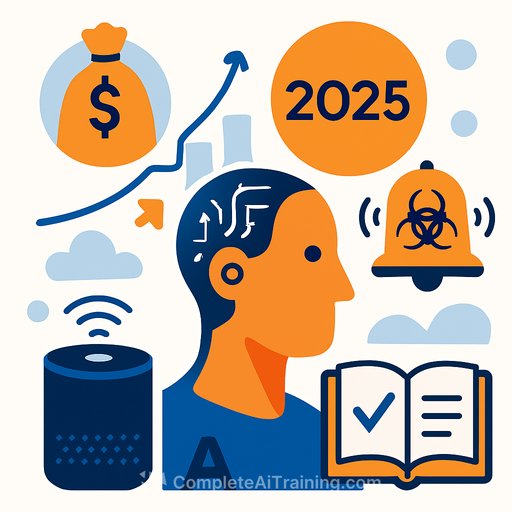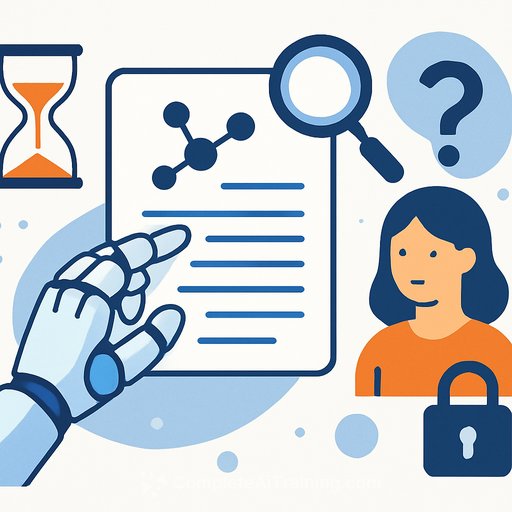AI In 2025: Practical Moves For Healthcare, Science, and Research Leaders
AI is setting the pace for the second half of 2025. Reports point to a fresh $300 million push by former leaders from major AI labs to build systems for materials science-work that could speed up sustainable energy research and new therapeutics. For labs and health systems, the message is clear: align infrastructure, data, and governance with AI-native discovery.
Funding Momentum Meets Scientific Discovery
Backers are targeting AI that can simulate, screen, and optimize materials at scale. Expect spillover into drug design, delivery mechanisms, and biocompatible compounds. Action: stand up a validation pipeline that pairs AI candidates with wet-lab assays, and budget for reproducibility studies-not just model benchmarks.
Consumer AI Signals Clinical Opportunity
Big tech is embedding generative AI into devices-new Echo units, smart home hubs, and ambient assistants. In clinical settings, this translates to voice-driven documentation, adherence nudges, and at-home monitoring. Pilot small: one unit, one use case, one metric (e.g., note completion time, patient response rate), then scale.
Biosecurity: Benefits With Real Risk
Experts warn that model capabilities now include designing harmful proteins if misused. The research upside is significant, but the guardrails must be tighter. Put in place sequence screening, tiered model access, and an internal biosecurity review that includes dual-use checks and external oversight.
- Restrict powerful generative tools behind approvals and audit logs.
- Use third-party sequence screening services before synthesis requests.
- Establish a red-team process for biological prompts and outputs.
Compute, Platforms, and Cyber Hygiene
New mobile and edge chips are posting strong memory and performance numbers, which matters for secure on-device inference. Institutions are also preparing for broad endpoint upgrades tied to OS support changes and AI PC requirements. Treat this as a chance to standardize encryption, MDM, and zero-trust access across research fleets.
- Procurement: require SBOMs, on-device encryption, and model isolation.
- Patch cadence: fast-lane updates for clinical and lab-critical apps.
- Incident readiness: tabletop exercises focused on model and data leaks.
Unity Android Flaw Reminds Us: Update Discipline Wins
A dormant engine-level vulnerability affecting millions of Android apps reinforces the obvious: update pipelines need to be boring and reliable. Automate scans, enforce minimum versions, and set deprecation dates for risky SDKs used in patient or trial-facing apps.
Robotics, Sensors, and Real-World Data
Forecasts suggest sensors will be everywhere to feed model training, with startups even exploring opt-in wearable cameras. For healthcare, think ambient vitals, facility flow, and post-acute recovery. Before deployment, lock down consent, retention, and on-device processing to reduce risk.
- Consent: plain-language, granular, and revocable.
- Data minimization: collect what you can act on, nothing more.
- Edge-first: process locally, send summaries, not raw streams.
Smart Devices and Imaging
AI-forward home devices and smartphone camera upgrades hint at better telehealth, wound tracking, and patient-reported imaging. Validate across demographics to avoid skewed outcomes. Build a reference set and run periodic bias checks before clinical use.
Regulation, Ethics, and Market Pressure
Regulators are assessing AI ethics and competition issues while health and climate applications move ahead. Keep an eye on antitrust and safety guidance that affects data partnership models and device interoperability. Good sources for ongoing coverage include MIT Technology Review (AI ethics) and Reuters Technology.
VC Flows Into AI-Enabled Biotech
Capital is moving into AI-for-health startups-faster trial design, biomarker discovery, and gene-editing support tools. Build partnerships that include data-sharing agreements, validation rights, and publication paths. Push for access commitments to avoid widening equity gaps.
Multimodal Models and Agents Move Into Practice
Expect models that unify vision and language to hit more workflows: imaging triage, EHR summarization, and lab automation. Agent-style tools are maturing for task orchestration. Start with bounded tasks, clear KPIs (turnaround time, error rate), and a human-in-the-loop sign-off.
Action Plan For Q4 2025
- Data: establish a unified, de-identified research layer with lineage tracking.
- Validation: pair every model with a domain-specific test harness and drift monitoring.
- Security: enforce role-based access, audit trails, and policy-based model gating.
- Biosecurity: implement dual-use review, synthesis screening, and capability controls.
- Devices: standardize on AI-capable endpoints with MDM, encryption, and secure boot.
- Compliance: align with IRB updates, model documentation, and transparency reports.
- People: train clinical and lab teams on prompt discipline, data privacy, and model limits.
Skill Up Your Teams
If your roadmap includes clinical AI, data analysis, or automation, invest in structured learning. See curated paths by role at Complete AI Training - Courses by Job and explore practical certification tracks such as AI for Data Analysis.
The second half of 2025 rewards leaders who move with clarity: tight scopes, measurable outcomes, and strong safeguards. Build the pipelines now so discovery, safety, and equity move together.
Your membership also unlocks:










